Type 3 and Type 6 Engines Are Heart of Wildland Fire Response
BY ALAN M. PETRILLO
Type 3 and Type 6 pumpers are the most widely used engines in wildland urban interface fire response because of their versatility, maneuverability, off-road abilities, and fire suppression capabilities. Apparatus manufacturers are turning out both custom engines and tried-and-true designs for fire agencies around the country, responding to those departments’ particular needs.
Bret Cerini, wildland product sales manager for the REV Group, notes that Type 3 and Type 6 wildland pumpers are the most popular types being used to fight wildland fires, especially in the Western states. “In the plains states, we see a lot of Type 5 pumpers with bumper turrets, which can carry a little more water, making them beneficial in mobile attacks,” Cerini points out. “The most common pump we see on those kinds of vehicles is the Darley 1.5AGE portable pump, which is the same model used by CAL FIRE as their auxiliary pump on their Model 34 (Type 3) engine.”
Bill Doebler, vice president of sales at HME Ahrens-Fox, says, “The HME Ahrens-Fox wildland product line depth and breadth is one of the most robust in the industry. Our engineers have listened to the needs of our customers and created a plethora of products to fill the needs as well as voids of wildland firefighting. We currently produce Type 1, Type 3, Type 6, WildMax, and a crossover vehicle designed to be a replacement for the Type 1 and Type 3 called the AF-WUI. In addition, we will soon be announcing a very large order for a customer in this marketplace.
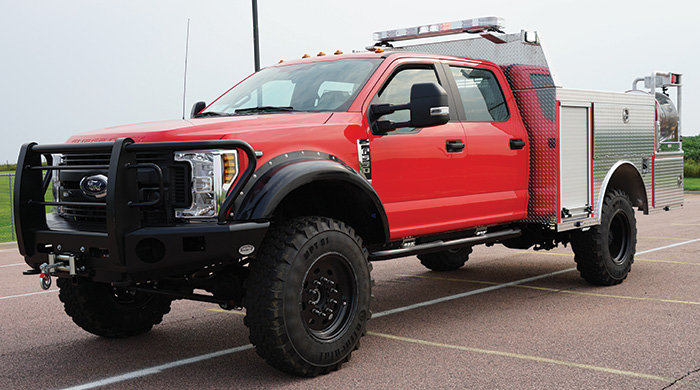
1 Rosenbauer built this Type 6 wildland engine for the U.S. Army. The rig is on a Ford F-550 four-door chassis and cab and carries a Hale HPX 150-gpm pump, a 300-gallon water tank, and a 20-gallon foam tank. (Photo courtesy of Rosenbauer.)

2 Pierce Manufacturing Inc. has developed the Wildland FX3 engine, a Type 3 pumper that can be built on either a Freightliner M2-106 chassis or an International HV chassis. (Photos 2 and 3 courtesy of Pierce Manufacturing Inc.)
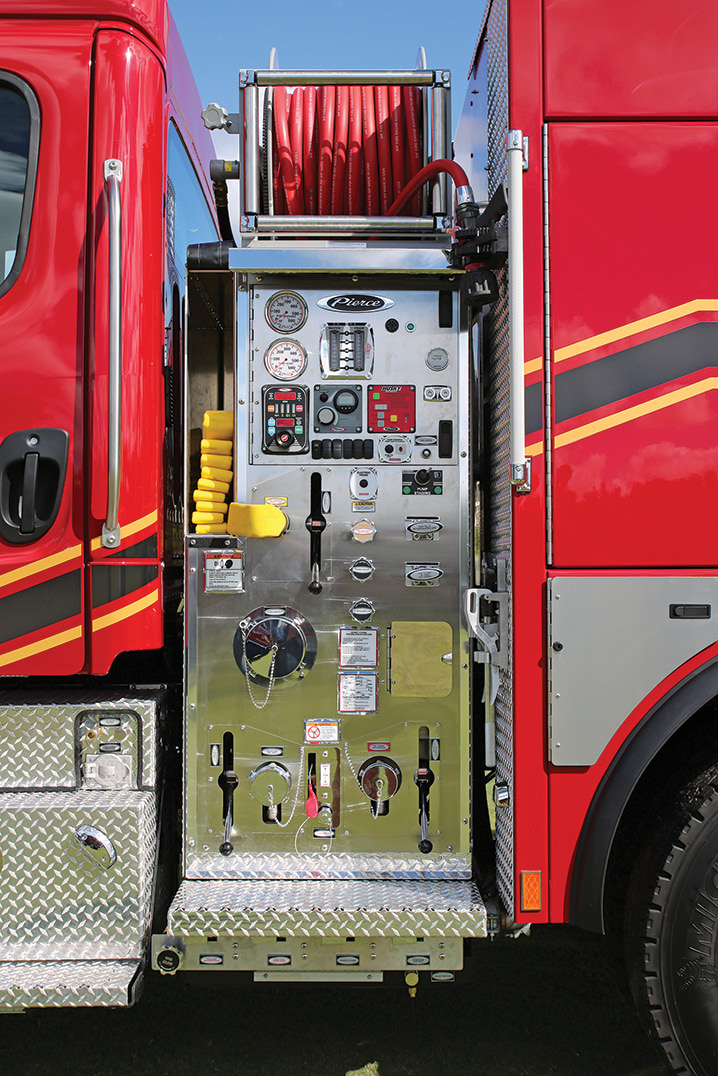
3 The pump house on Pierce’s new Wildland FX3 engine.

4 REV Group built this Type 6 wildland engine for the Pahoa (HI) Fire Department. (Photos 4-6 courtesy of the REV Group.)
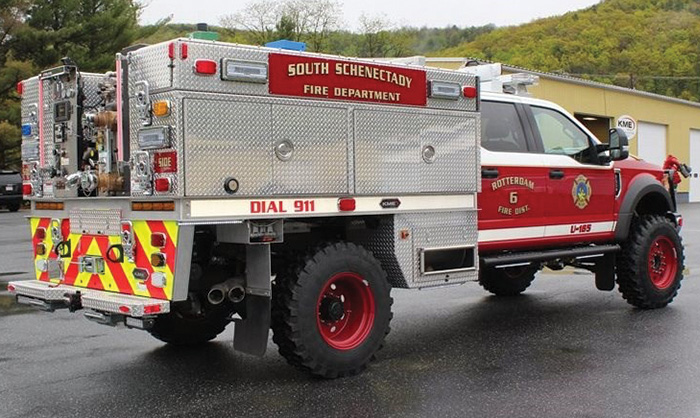
5 Rotterdam (NY) Fire District had KME build this Type 6 engine for its South Schenectady Fire Department.
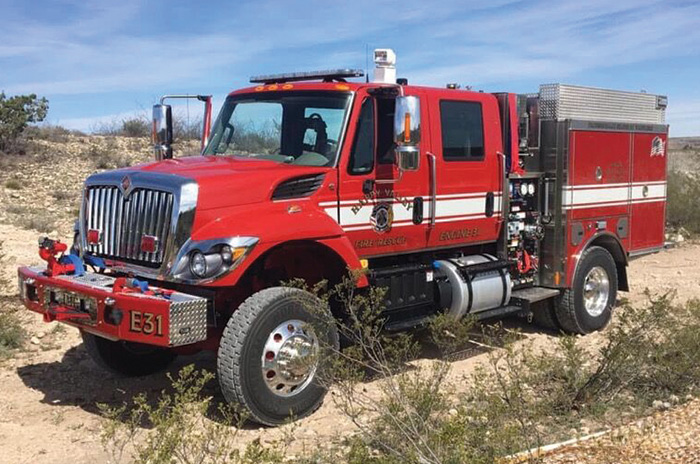
6 This HME Ahrens-Fox Type 3 wildland apparatus is in service with the Happy Valley (NM) Fire Department in Eddy County. It is built on an International 7400 four-door cab and chassis, is powered by a Cummins ISL9 engine, and features a 1,000-gpm pump. (Photo courtesy of HME Ahrens-Fox.)
Larry Segreto, vice president of Boise Mobile Equipment, says that “the ground clearance is much better on a Type 3 wildland engine; its pumping ability is greater, including pump and roll; and it generally has better wheels and tires than Type 6 wildland engines. It’s the bread-and butter-wildland engine in much of the Western United States.” He adds that “typically, Type 6 engine purchases are driven by price range, but they have their own attributes, like maneuverability, and being very handy in brushy country.”
TYPE 6
Doug Feldman, western region sales manager for Rosenbauer, says, “Type 6 vehicles have exploded in popularity, especially in the Western states where 90 percent of the calls most departments run to can be handled by a Type 6 unit. The big advantages of a Type 6 pumper are the up-front cost and the long-term cost of ownership being much less on a Type 6 than on a Type 1 engine.”
He says that California’s Governor’s Office of Emergency Services (OES), which typically has purchased Type 3 wildland engines, “just bid out 110 Type 6 wildland engines with dual pumps: a PTO-driven Darley 500-gallon-per-minute (gpm) midship pump and a Darley 1.5AGE auxiliary pump. They wanted maneuverability, a smaller footprint, and lower cost of ownership.” Feldman says he expects the purchase price on the OES Type 6 “will come in at $225,000 to $250,000 instead of $400,000 for a Type 1 engine.”
Troy Carothers, AutoCAFS manager for W.S. Darley & Co., says Darley has focused on Type 6 engines for a while and recently produced an off-road version of the MaxWASP Type 6/quick-attack pumper. Carothers says the MaxWASP has a Darley 1,500-gpm PSMC pump, a 300-gallon water tank with a 25-gallon integral foam tank, a Darley AutoCAFS 1 system, and a 120-cubic-feet-per-minute (cfm) rotary screw air compressor driven off the main fire pump transmission. The vehicle has a six-inch lifted suspension and Super Single wheels and tires.
Perry Shatley, wildland sales manager for BFX Fire Apparatus, believes maneuverability is one of the most important advantages of a Type 6 wildland engine. “The Type 6 engine can go places in the wildland urban interface that bigger pumpers can’t go but still can offer robust pump performance,” Shatley says. “We use Darley, WATERAX, Waterous, and Hale pump packages on our Type 6 engines, typically in the 100- to 150-gpm range at 100 pounds per square inch (psi) pressure.”

7 W.S. Darley & Co. has developed the MaxWASP Type 6/quick-attack pumper with a Darley 1,500-gpm PSMC pump, 300-gallon water tank, 25-gallon integral foam tank, and Darley AutoCAFS 1 system. (Photo 7 courtesy of W.S. Darley & Co.)

8 BFX Fire Apparatus built this Type 6 wildland engine for the Burkburnett (TX) Fire Department. Note the front discharge and road spray discharges on the front of the rig. (Photos 8-10 courtesy of BFX Fire Apparatus.)
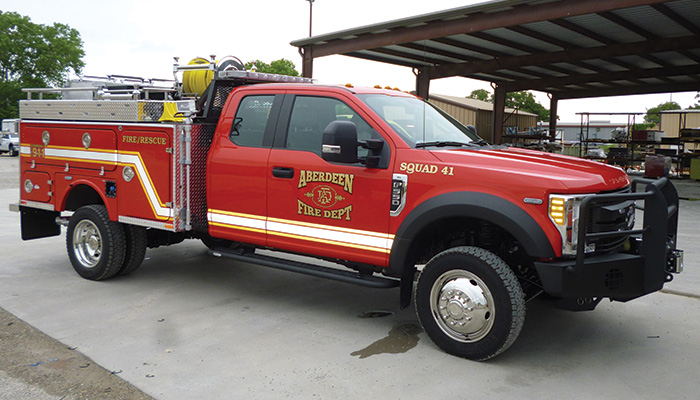
9 The Aberdeen (NC) Fire Department had BFX Fire Apparatus build this Type 6 wildland/quick-attack pumper.

10 Tillamook (OR) Fire District had Spartan ER build this RAGE Type 3 pumper.
Justin Frost, BFX’s general manager, notes that he’s seeing more departments choose dual hose reels on their Type 6 pumpers instead of the typical single hose reel. “Besides the hose reels, the Type 6 engines typically carry a 1- to 1½-inch discharge at the rear of the vehicle and may have side discharges, a front bumper discharge, and front road sprays for mobile attack,” he says.
Todd Nix, apparatus consultant for Unruh Fire, says Unruh has been seeing more interest from fire departments in moving away from skid units on Type 6 wildland pumpers to midship 500-gpm pumps. “They can do more with a vehicle like that and cross use that wildland truck for other functions like car fires and other nonstructure fires.”
However, Nix says, Unruh continues to build plenty of Type 6 wildland pumpers using Hale, Darley, and Waterous portable pumps on skids. “We recently built a Type 6 for the Pueblo (CO) Fire Department on a Ford F-550 4×4 Super cab and chassis with a lifted suspension and Super Single wheels and tires,” Nix notes. “The pumper has a Hale HPX200-B23 pump, 400-gallon water tank, a 10-gallon foam tank, a FoamPro 2001 foam proportioner, a Hannay hose reel with one-inch hoseline, and ditch sweep discharges.”
Greg Blanchat, president of Blanchat Manufacturing Inc., points out that the Type 6 wildland pumpers used by fire departments in the plains states and the Midwest are very different than those used in California and other Western states. “The fires move so fast through the plains that you must have your firefighters on the truck in the attack position behind the cab with rollover protection and safety gates,” Blanchat says. “A Type 6 vehicle with a skid unit pump is better for chasing prairie fires, which often are moving at 30 to 35 miles an hour.”

11 Unruh Fire built this Type 6 wildland pumper for the Pueblo (CO) Fire Department on a Ford F-550 4×4 Super cab and chassis with a lifted suspension and Super Single wheels and tires. (Photos 11 and 12 courtesy of Unruh Fire.)
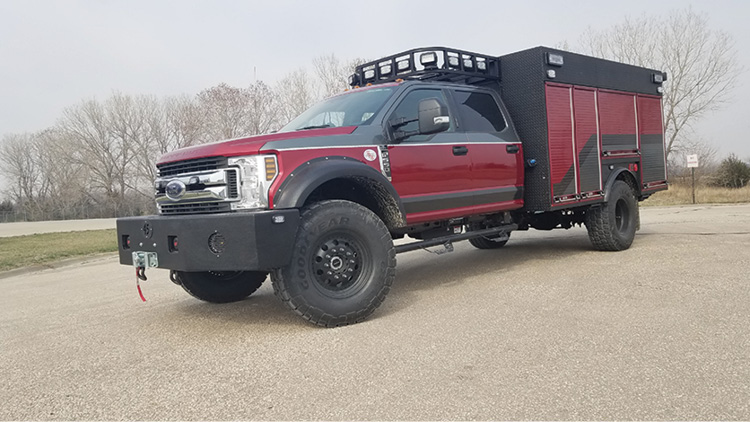
12 The Mid-County St. Louis (MO) Fire Department had Unruh Fire build this Type 6 wildland engine.
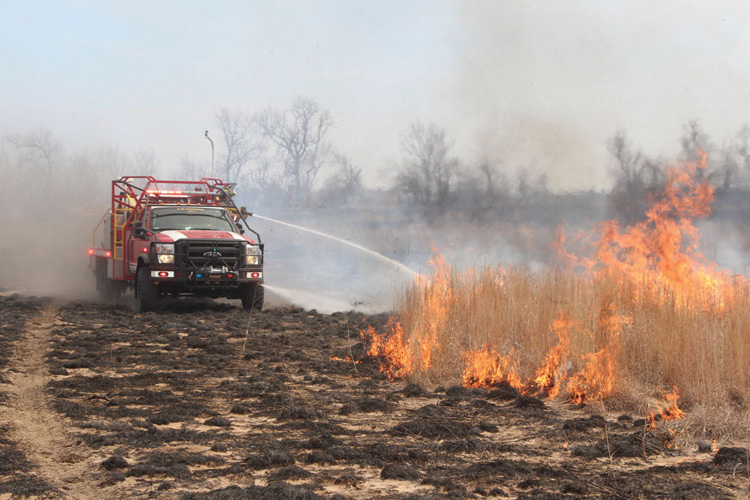
13 A Type 6 wildland engine built by Blanchat Manufacturing Inc. uses its bumper turret and attack position handline to fight a prairie fire from the black. (Photos 13 and 14 courtesy of Blanchat Manufacturing Inc.)

14 A Blanchat-built Type 6 wildland engine operates in the fuel while using its midship-located attack line to fight a prairie fire.
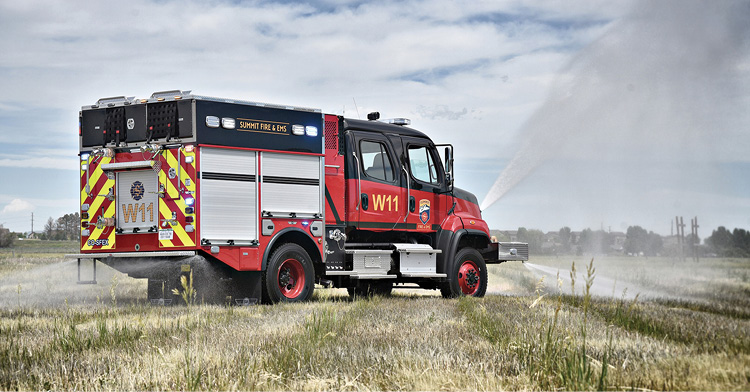
15 SVI Trucks built this Type 3 wildland engine for Summit (CO) Fire & EMS on a Freightliner 108SD 4×4 chassis with a Hale MBP single-stage 750-gpm pump, 500-gallon water tank, 20-gallon foam cell, Darley 1.5AGE diesel auxiliary pump, and FoamPro foam system. (Photos 15-17 courtesy of SVI Trucks.)
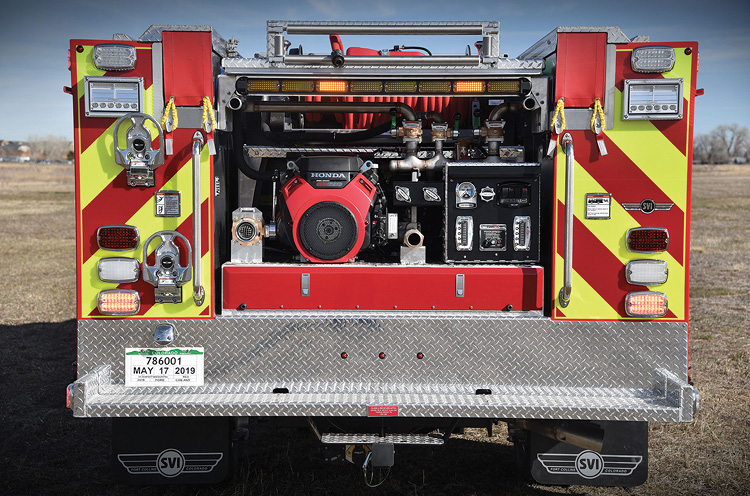
16 The Type 6 wildland engine SVI Trucks built for the Kremmling (CO) Fire Department features a Mercedes centrifugal pump powered by a 24-horsepower Honda engine and a 300-gallon water tank with removable top.
Many Type 6 wildland pumpers in the plains states use one percent foam concentrate as a wetting agent, Blanchat maintains. “A lot of rural departments can’t afford foam systems, so they will mix one gallon of foam for each 100 gallons of water they carry in their water tank to get that one percent concentration,” he points out. “The departments try to stay in the black but sometimes have to be in the fuel to fight the fire, and if they do, they have their bumper sweeps on so they soak the underside of the truck and wet down the fuel.”
Jason Kline, Colorado and Wyoming sales manager for SVI Trucks, says SVI has recently “built quite a few Type 3 wildland pumps, as well as Type 6 pumpers on both custom bodies and bolt-on flatbeds. We also built a Type 4 wildland pumper for Loveland (CO) Fire Department that has a pump-and-roll capability and carries 650 gallons of water.”
Chris Maikranz, business development director for General Truck Body’s First Responder Division, notes that the 100-year-old company has been building first responder vehicles for the past three years. “We’re seeing departments choose the Ford F-550 chassis for Type 6 engines and also the Ram 5500 chassis,” Maikranz says. “Very often they will have us put a six-inch lift on the suspension and add Super Single wheels and tires.” He notes that General Truck Body has built “a couple of different high-profile flood vehicles that are being redeveloped into Type 3 and Type 6 wildland vehicles with extreme off road capabilities.”
Jeff Cook, owner of 1st Attack Engineering, says his company hasn’t done much with Type 3 engines, “but we have built a lot of Type 6 wildland pumpers, and even smaller ones, on Ford F-450 and F-350 chassis. We’ll usually put on a portable pump of 150 gpm to 500 gpm and most commonly 200 gallons of water,” he adds. “Some of these Type 6 pumpers are fitted with an around-the-pump foam system to make them more versatile.”
TYPE 3
According to Doebler, there are two types of markets for Type 3 rigs. “We call them the City style Type 3 and the Suburban style Type 3,” he says. “They are just as they sound, with the City style requiring more option content such as aluminum wheels, additional warning and scene lights, upgraded seating, upgraded shelves and trays, and a more feature-driven vehicle specific to each fire department’s needs. The Suburban model is more utilitarian, or as we like to call it the “battle wagon,” and designed for heavy usage during wildfire season. This model has been the core of the wildland product that we manufacture for the California market, having produced in excess of 350 units.”
Feldman notes that Type 3 engines used throughout the country, and heavily in the Western states, have a larger footprint and are heavier and less maneuverable than a Type 6 but have fewer limitations for ladder and hose storage; can carry more water, typically 500 gallons; and work well in the wildland urban interface.
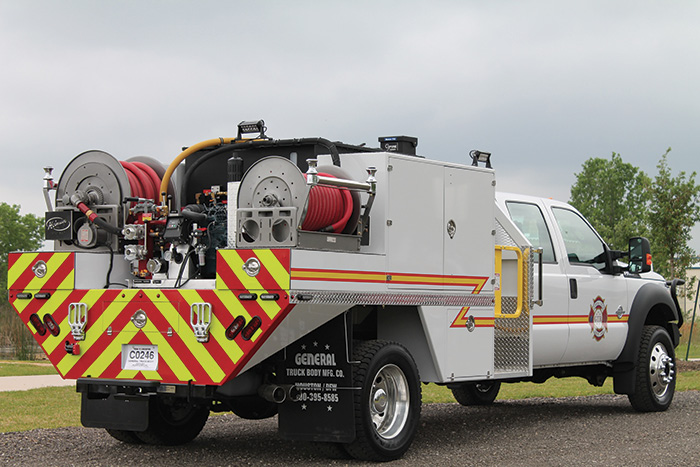
17 General Truck Body built this Type 6 wildland engine for the Taylor (TX) Fire Department on a Ford F-550 4×4 crew cab and chassis with a Waterax pump powered by a Kubota engine and a 400-gallon polypropylene water tank with a 10-gallon integrated foam tank. (Photos 18 and 19 courtesy of General Truck Body.)

18 The Sand Hills (TX) Fire Department had General Truck Body build this Type 6 with a Hale pump powered by an 18-horsepower Briggs & Stratton gasoline engine and a 400-gallon polypropylene water tank with a 10-gallon integrated foam tank.
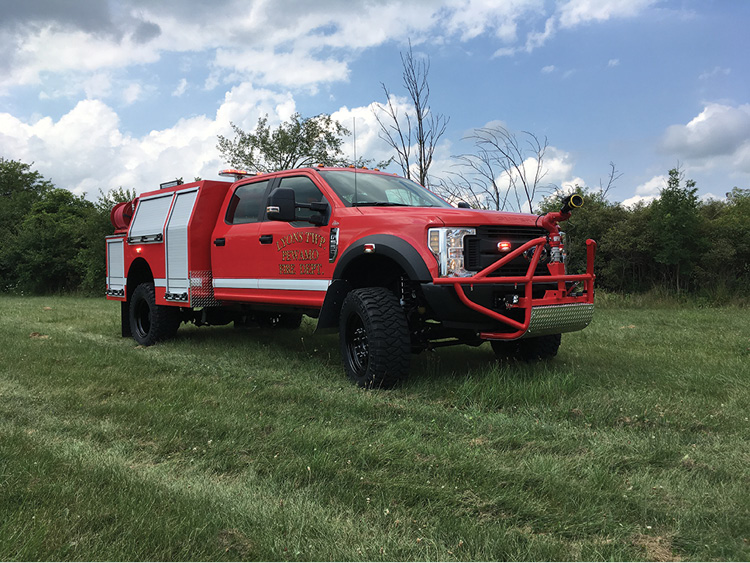
19 1st Attack Engineering built this Type 6 wildland pumper/rescue truck for the Pewamo (MI) Fire Department. (Photo courtesy of 1st Attack Engineering.)
Scott Kiernan, project manager for Pierce Manufacturing Inc., points out that Pierce has developed a new model Type 3 pumper called the Wildland FX3 that is compliant with NFPA 1901, Standard for Automotive Fire Apparatus. “We asked wildland firefighters what they wanted to see on a Type 3, and they told us to maximize the storage space; provide dedicated storage for their red bags; and give greater ease of access for serviceability, which is important in remote areas. We put all those elements in the new Wildland FX3 and improved the angle of approach and departure on the vehicle.”
Wyatt Compton, fleet sales application engineer for Spartan ER, says his company makes the Spartan RAGE Type 3 engine with a 750-gpm two-stage pump, a 500-gallon water tank and integrated foam tank, a Darley 1-1/2AGE 24K diesel pump, stainless steel plumbing, an enclosed ladder compartment in the body, and hard suction enclosed above compartment roll-up doors. Compton notes that its unitized body mounting “provides for the most extreme flex in the industry, using a pair of mounts at the front of the substructure with antivibration pads on the frame flanges and sliding rear mount. This allows 10 degrees of difference between front and rear axles or 17 inches difference in suspension travel and chassis flex, which is critical in wildland environments to allow the pump, pump enclosure, and plumbing to move along with the body as a unit.”
Kiernan says the Wildland FX3 is available on a Freightliner M2-106 chassis or an International HV chassis, carries either a 500-gpm Darley JMP500 two-stage pump or a 1,000-gpm Darley LSP1000 single-stage main pump and a hydraulically-driven Darley 1.5AGE auxiliary pump packaged with a pressure governor control on the pump panel and in the truck’s cab, a Husky™3 or FoamPro 1600 foam system, a 500-gallon water tank, and a 20-gallon foam tank. The Wildland FX3 has left- and right-side hose trays for 50 feet of 1¾-inch hose, a center tray for 75 feet of 1¾-inch hose, and up to 119 cubic feet of compartment space.
Cerini says that in a number of Northwestern states, such as Montana, Wyoming, Idaho, Washington, and Oregon, “We are seeing more Type 4 engines being used, usually with two-door cabs and 750 gallons of water.” But, Type 3 engines are the most common wildland engine found throughout the West, Cerini believes. “At KME, we call our Type 3 the Interface pumper because it can work a wildland fire as well as do an initial attack on a structure fire, which is exceptionally useful in the wildland urban interface.”
Doebler adds, “This market segment is not one that is going away. If anything, the products being designed will continue to be more robust, more automated, and able to handle the heavy lifecyle requirements that are placed on apparatus that do battle with wildfires. Unless something changes with our climate and vegetation in the west, coupled with population growth, we will continue to see an increase in the requirement to innovate how our nation’s bravest tackle these fires.”
ALAN M. PETRILLO is a Tucson, Arizona-based journalist, the author of three novels and five nonfiction books, and a member of the Fire Apparatus & Emergency Equipment Editorial Advisory Board. He served 22 years with the Verdoy (NY) Fire Department, including in the position of chief.

